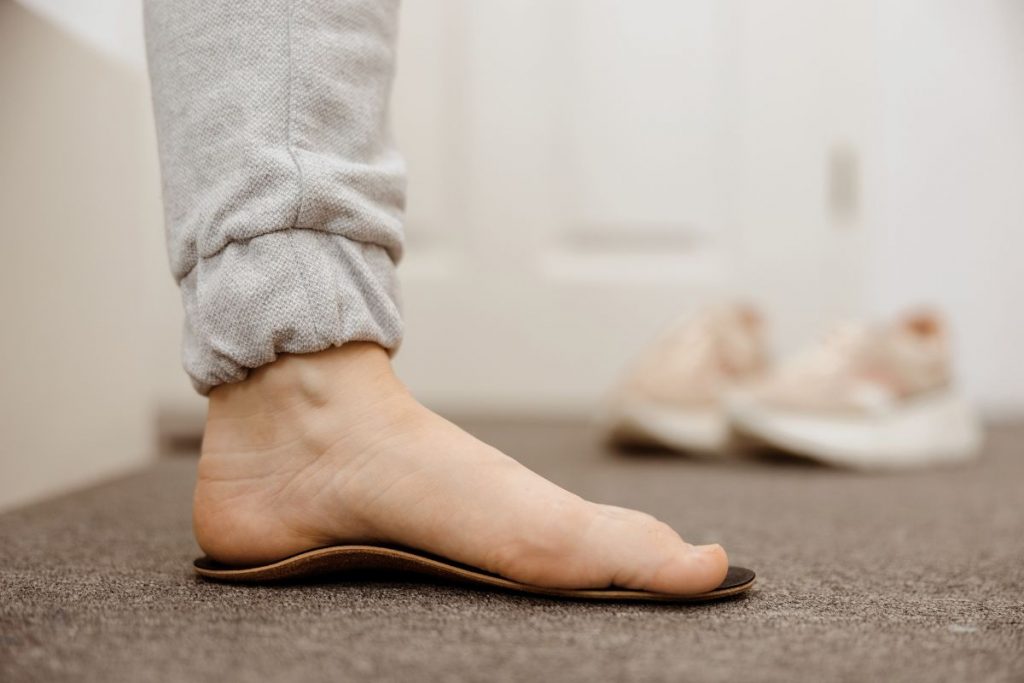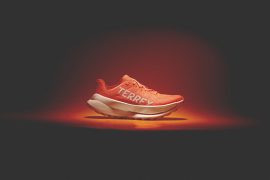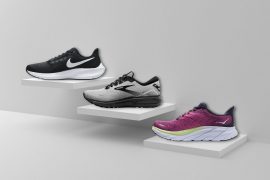Running is one of the most popular forms of exercise around the globe, and the right pair of running shoes can make all the difference to your performance and comfort. With the variation in foot types – flat, neutral, or high arch – it becomes crucial to choose a shoe that’s the best fit for your unique foot structure. Let’s explore the best running shoes for different foot types in 2023 to help you make an informed decision.
Read more: Best Running Shoes for Heavy Runners 2023
Running Shoes Featured in This Article
Which is my foot type?
Determining your foot type can help guide your choice in footwear and identify any potential foot problems that might require special care or treatment. The three most common foot types are flat, neutral, and high arch.
Here are several ways to identify your foot type:
1. Wet Test (Footprint Test): This is a simple and popular way to determine your foot type.
- Begin by wetting your feet.
- Step onto a surface that will show your footprint. This could be a brown paper bag, a piece of heavy construction paper, or concrete.
- Step off and look at the imprint. If you can see most of your footprint, you likely have flat feet. If the imprint shows only a portion of your foot (mainly the outside edge and a thin line along the inside), you probably have high arches. A footprint with a moderate amount of the middle part of your foot visible (about half) would indicate a neutral or “normal” arch.
2. The Wear Pattern on Your Shoes: Look at an old pair of shoes and observe where they’re most worn down.
- People with flat feet tend to have more wear on the inside edge of the shoe.
- Those with high arches may see the most wear on the outside edge.
- Neutral feet often show wear across the ball of the foot and a slight wear on the heel.
3. Professional Assessment: Podiatrists, orthopedic specialists, and even some specialized sports stores can perform an assessment of your foot type. They may use digital footprint technology or other specialized methods to assess your arch type and foot structure.
4. Feel and Observation: Simply looking at and feeling your feet can provide clues. High arches are often easy to spot, while flat feet may cause your ankles to roll inward when you stand or walk.
5. Flexibility Test: Stand on your toes or flex your foot. If your arch appears when you do so, you may have flexible flatfoot, a common condition where the arch appears when the foot is not bearing weight but flattens when you stand.
While these methods can help you determine your foot type, if you’re experiencing discomfort, pain, or other issues, it’s important to seek professional advice from a podiatrist or other healthcare professional. They can provide a more precise diagnosis and guide you towards the appropriate treatment or interventions.
Best Running Shoes for Different Foot Types 2023
Choosing the right running shoes can dramatically enhance your performance and comfort during exercise. This guide will help you navigate through the best running shoes for different foot types in 2023: flat feet, neutral feet, and high arches.
We’ll delve into key considerations and top picks for each category, ensuring that no matter your foot type, you have a shoe that meets your unique needs. Get ready to discover footwear that not only fits perfectly but also boosts your running experience.
For Flat Feet
People with flat feet have a low arch or no arch at all, leading to their feet rolling inward when running, a condition known as overpronation. The ideal running shoes for flat feet are those with high stability and support to counter overpronation.
Asics GT-2000 Series
Known for their incredible stability, the GT-2000 series from Asics provides enhanced support and comfort for flat feet. The shoes feature a dual-density midsole and a Trusstic System technology that ensures better stability and prevents the foot from rolling inwards.
Brooks Adrenaline GTS Series
Another stellar choice, these shoes are built with overpronators in mind. Their GuideRails holistic support system is designed to keep excessive movement in check, while the cushioned yet responsive midsole ensures a comfortable ride.
For Neutral Feet
Neutral feet are biomechanically balanced and do not lean inward or outward significantly. Neutral or cushioned running shoes are best for this foot type as they provide ample shock absorption without extra stability devices.
Adidas Ultraboost Series
With its responsive boost midsole and flexible stretchweb outsole, Adidas Ultraboost shoes adapt to the way your foot hits the ground, making it ideal for runners with a neutral gait. Its Primeknit upper provides a supportive fit.
Nike Air Zoom Pegasus Series
Renowned for their comfort and versatility, the Nike Air Zoom Pegasus shoes offer responsive cushioning that caters well to neutral runners. The shoe’s breathable mesh upper and secure fit make it a reliable choice for long runs.
For High Arch Feet
High arch feet tend to underpronate or supinate, meaning the feet roll outwards when running. Running shoes with extra cushioning and flexibility can help absorb shock and aid in natural foot motion.
New Balance 1080 Series
Offering generous cushioning and a comfortable fit, the New Balance 1080 is a go-to for runners with high arches. The shoe’s Fresh Foam midsole provides advanced cushioning, ensuring a plush ride.
Saucony Triumph Series
The Triumph series from Saucony offers superior cushioning, thanks to the brand’s EVERUN and PWRRUN technologies. The shoes are designed with added flexibility to accommodate the outward roll of high-arched feet.
In conclusion, understanding your foot type and choosing the appropriate running shoe can significantly impact your running comfort, performance, and injury risk. No matter if you have flat, neutral, or high-arched feet, there is a shoe out there designed with your needs in mind.
Always remember, when trying on any running shoe, it should feel comfortable right away. If it doesn’t, it’s probably not the right shoe for you. Here I’ve given you some options when you are looking for the best running shoes for different foot types in 2023.
What to think about when buying running shoes for Different Foot Types?
When buying running shoes, it’s important to consider your foot type. This can greatly influence your running gait and pronation (the inward roll of the foot while walking or running). Here are some considerations for different foot types:
- Flat Feet (Overpronation): Overpronation is common in individuals with flat feet. When your foot comes into contact with the ground, it rolls inward more than the ideal 15%, which can cause injuries. For this foot type, motion control or stability running shoes are recommended. These shoes provide good support and have firm midsoles to help reduce pronation. They also typically have a medial post or dual-density foam that provides extra support on the arch side of the midsole.
- Neutral Feet (Neutral Pronation): If you have a neutral foot, it means your foot lands on the outside of the heel, then rolls inward slightly to absorb shock. Neutral runners usually have semi-flexible arches that neither roll inwards nor outwards too much. Runners with this foot type can usually wear any type of shoe, but they may find the best comfort in neutral shoes that offer some shock absorption and some medial (arch side) support.
- High Arches (Underpronation or Supination): People with high arches tend to underpronate, or supinate, meaning their feet roll outwards as they run. This can place extra stress on the outer edge of the foot and cause impact-related injuries. Cushioned (or neutral) shoes are recommended for runners with high arches. These shoes are typically more flexible and have a softer midsole to encourage natural pronation. They lack stability devices and have a uniform midsole density to provide cushioning and support.
Other general factors to consider when buying running shoes are:
- Size: Your running shoes should be a half size to a full size larger than your regular shoe size because your feet swell when running.
- Fit: Ensure there’s enough space (about a thumb’s width) between your longest toe and the front of the shoe. The shoe should fit snugly around the heel, and your foot should not slip out when you run or walk.
- Comfort: Choose shoes that feel good when you’re running, not just when you’re standing.
- Use: If you’re running on trails, you might want shoes designed for off-road with better traction. If you’re running on roads, lighter shoes with more cushioning may be preferable. If you plan to run races, you might want a lightweight racing flat.
- Previous injuries: If you’ve been injured while running before, consider shoes that address the cause of the injury. For example, shoes with more cushion might be needed for runners who have suffered from shin splints.
Remember, every runner is unique, so what works for one person might not work for another. Always consider your personal comfort, running style, and any advice from professionals when choosing running shoes. It’s often beneficial to get fitted at a specialist running store where the staff can assess your foot type and recommend appropriate shoes.
FAQs
Flat feet need shoes with good stability and support to prevent overpronation. Some of the best running shoes for flat feet include Brooks Adrenaline GTS, ASICS Gel-Kayano, and New Balance 860V11. However, the specific shoe that works best can vary depending on personal comfort and the extent of your pronation.
Neutral runners can typically wear a variety of running shoes, but often benefit most from shoes with a good balance of cushioning and support. Some options include Brooks Ghost, Nike Air Zoom Pegasus, and Hoka One One Clifton. As with any shoe, fit and personal comfort should guide your choice.
High arches often require shoes with extra cushioning to absorb shock since the foot may not be able to distribute weight as effectively. Shoes like the Brooks Glycerin, Saucony Triumph, and Hoka One One Bondi are often recommended. A shoe with a high drop (the difference in height between the heel and the forefoot) may also be beneficial.
One simple method is the “wet test”. Wet your foot, step onto a piece of cardboard, and look at the footprint. If it shows most of your foot, you likely have flat feet. If it shows very little, you likely have high arches. If it shows about half your foot, you likely have a neutral arch. A professional running shoe store can also analyze your gait and provide more detailed advice.
Overpronation occurs when the foot rolls inward excessively after landing. This often happens with flat feet. Underpronation, or supination, is when the foot rolls outward too much. This is often seen in people with high arches. Both can lead to injury if not addressed with the appropriate footwear or orthotics.
Most running shoes should be replaced after 300-500 miles of use, or about every 4-6 months for regular runners. Signs of wear, discomfort, or the onset of joint and muscle pain can also indicate it’s time for a new pair.
While shoes can’t replace training, the right pair can help optimize your performance by improving comfort and reducing the risk of injury. A shoe that matches your foot type and running style can make running more efficient and enjoyable.
While it’s possible, regular sneakers may not provide the support and cushioning necessary for running, especially over longer distances. This can increase the risk of injury. It’s generally recommended to invest in a pair of shoes designed specifically for running.







